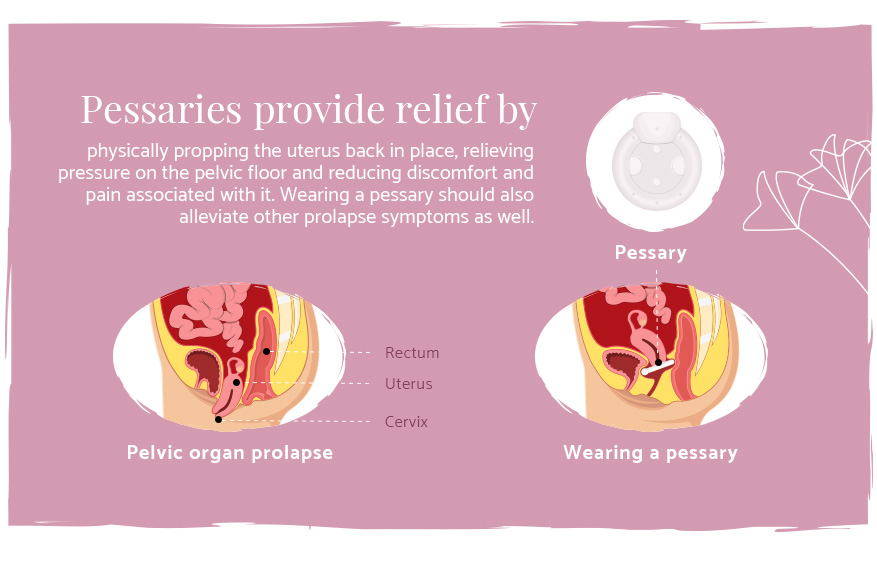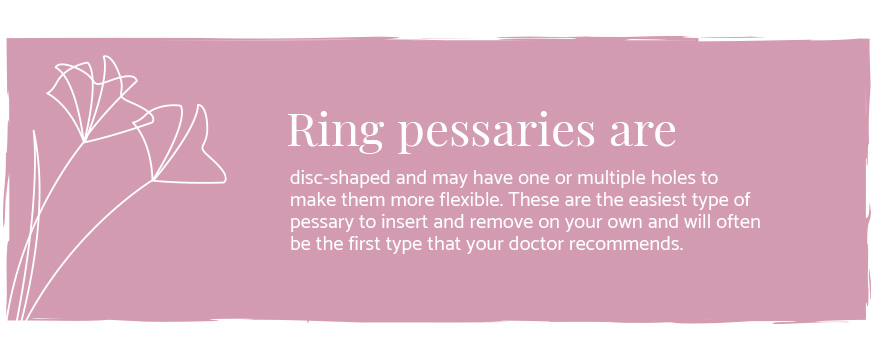
Pessary Fittings: Everything You Need to Know

A pessary is a soft, removable device that is inserted into the vagina in order to provide support for intimate organs. It is often prescribed in cases of pelvic organ prolapse (abbreviated as POP, we’ll share more on this condition in a minute.) Pessaries are usually made of silicone, which is a body-safe, flexible material that will conform to the shape of your pelvic organs for comfortable wear. Some pessaries are designed to be removed frequently for cleaning or certain activities such as sex, while others are designed to be left in the body for longer periods of time.
In this guide, we explain what pelvic organ prolapse is and how a pessary can help manage the symptoms. Then, we cover the different types of pessaries and explain what a pessary fitting entails. Finally, we offer some tips for caring for your pessary at home and wearing the medical device as comfortably as possible.
Here’s what you need to know about pessary fittings:
Understanding Pelvic Organ Prolapse
Pelvic organ prolapse occurs when the muscles and ligaments of the pelvic floor weaken and stretch out. Without this support, the pelvic organs can slip out of place and sag downwards. Symptoms of pelvic organ prolapse include:
- A feeling of heaviness or pressure in the pelvic area
- Pain in the pelvic area (may also spread to the abdomen and/or lower back)
- Uterine tissue falling into or out of the vagina
- Unusual or excessive vaginal discharge
- Constipation and other difficulty with bowel movements
- Frequent bladder infections
- Problems with urination, including incontinence, urinating frequently, and the overwhelming urge to urinate

These symptoms may get worse when you stand or walk for long periods of time because gravity is putting more pressure on your pelvic floor. (To learn more about bladder prolapse, a related but separate condition, see our in-depth post on signs of a prolapsed bladder.)
Learn More About Bladder Prolapse Here
Pelvic floor prolapse is a relatively common condition that often occurs in post-menopausal people who have had multiple vaginal deliveries. As you age, all your muscles become weaker, and physically stressful events such as vaginal delivery can hasten this process and cause prolapse after birth. Your body also stops producing estrogen when you go through menopause, and since estrogen helps keep your pelvic muscles strong, this can further contribute to uterine prolapse. Other risk factors for prolapse include a family history of the condition, injury during childbirth, giving birth to large babies greater than nine pounds, obesity, chronic coughing or straining, and chronic constipation.
To diagnose pelvic organ prolapse, your doctor will perform a physical vaginal examination using a speculum. They will insert the speculum into your vagina and use it to feel around the vaginal canal and the uterus to see if the uterus has lowered from its normal position and is causing any bulges in the vagina. If your medical provider determines that you have pelvic organ prolapse, then they may recommend wearing a pessary to help prop the uterus back into place.

Using a Pessary for Pelvic Organ Prolapse
Pessaries can help manage multiple symptoms of pelvic floor prolapse. They do not cure the condition, but they do provide support and help tighten up the pelvic tissues. In cases of mild pelvic prolapse, the pessary may provide enough support for the tissues to heal on their own, mitigating the need for surgery. In other cases, they can act as temporary relief until the patient is ready for surgery.
Pessaries may be used to support the pelvic floor organs until childbearing is complete. They may also be used in pregnant women who are experiencing temporary prolapse due to the pressure the growing baby puts on their pelvic floor. Pessaries are also used for patients who have other conditions, such as heart or lung disease, that makes other kinds of surgeries risky.
Pessaries provide relief by physically propping the uterus back in place, relieving pressure on the pelvic floor and reducing discomfort and pain associated with it. If you have other symptoms caused by the prolapse, such as constipation, then wearing a pessary should also alleviate those symptoms as well.

Your doctor may also prescribe wearing a pessary in cases of stress incontinence, which occurs when forceful actions such as coughing, sneezing, jumping, and laughing put stress on the pelvic floor muscles. If the muscles are weak, this sudden stress can cause the bladder muscles to temporarily lose control, causing urine to leak out. Using a pessary to relieve pressure on the pelvic area can help mitigate stress incontinence in some women.
Feel Protected with Bladder Control Products
Other Treatment Options for Pelvic Organ Prolapse
Pessaries are not the only option for treating prolapse. Your doctor might also recommend that you do pelvic floor therapy. These exercises engage the muscles of your pelvic floor and may be done with or without Kegel balls inserted. To perform a kegel, tighten your muscles as if you are holding back urine and then release them. Your doctor will tell you how many repetitions to repeat and how often.
In cases of more serious pelvic organ prolapse, the uterus may be removed entirely in a hysterectomy. The surgeon may also repair prolapse without removing the uterus, which is accomplished by putting the uterus back in its normal place and reattaching the uterine ligaments. If you want to get surgery for your pelvic organ prolapse, talk to your doctor about your options.
Types of Pessaries
There are multiple types of pessaries available. Some of the most common are:

- Ring pessaries are disc-shaped and may have one or multiple holes to make them more flexible. These are the easiest type of pessary to insert and remove on your own and will often be the first type that your doctor recommends.
- Gehrung pessaries are U-shaped and are often recommended for more advanced cases of uterine prolapse. These are custom molded to fit patients to ensure a comfortable fit.
- Gellhorn pessaries are shaped like disks with a small knob protruding from one side. The knob is used to push the pessary upward and is used in more severe cases of prolapse.
- Cube pessaries look like rounded cubes with circular indentations in each side. This design allows them to be compacted down and inserted into the vagina, where they expand and use suction to support the prolapsed organs. Cube pessaries are used for advance stage prolapse.
Getting a Pessary Fitting
If you’ve never worn a pessary before, your doctor will first perform a vaginal exam to determine if you would be a good candidate for wearing one. If they think a pessary is a good solution for you, then they will take measurements and fit you for one in their office. To determine the fit of the pessary, the physician will have you perform exercises such as squats with the pessary inside and also have you use the restroom to make sure that you can urinate and defecate without issue.
It’s important to get a pessary that is the right size and shape for your body. If the pessary is too small, it will fall out, and if it’s too large, it will create discomfort and pressure. It may take a couple of different tries to find the right pessary for you.
Here are some ways to know if your pessary fits you well or not:
- When you lie down on your back and relax, your pessary shouldn’t move out of place. If it does, you might need to be refitted with a larger size.
- When standing or walking, the device should stay in place and not cause any discomfort. If you cough, laugh, bend over, or squat, the device should also stay in place. If it doesn’t, you might need to try a larger size or a different shape.

- Wearing a pessary should not interfere with urinating at all. You should be able to completely empty your bladder without difficulty or feeling like you still have some urine left inside. A pessary also should not compromise your bladder control. If you start having issues with emptying your bladder after being fitted for a pessary, contact your doctor immediately so you can get refitted.
- Similarly, wearing a pessary should not interfere with emptying your bowels either. It should not cause constipation or make it difficult to completely empty your bowels. If you do experience difficulty, then contact your medical provider immediately.
- Pessaries should fit comfortably and you should not be able to feel them after getting them in the correct position. The pessary also should not fit too tightly in the vagina. You should be able to run a fingertip between the edge of the pessary and your vaginal walls. If you feel pain or discomfort when wearing the pessary, or it feels too tight, then reach out to your doctor about getting another fitting and possibly a different size pessary.
- Vaginal bleeding may occur after wearing a pessary for a very long time if the pessary rubs against the vaginal walls too often. You should always contact your doctor any time you experience unexplained vaginal bleeding, regardless of whether or not you wear a pessary.
Caring for Your Pessary at Home
Before inserting or removing your pessary, you should wash your hands thoroughly with soap and water for at least 20 seconds. Make sure that your hands are totally dry before trying to handle the pessary, as having slippery hands can make it difficult to handle. The pessary should be removed and cleaned at least once every three months, or however often your doctor has instructed you to remove it. If you cannot remove the pessary on your own, they will have you come into the doctor’s office so they can do it for you properly.
When removing or inserting the pessary, choose a position that is comfortable for you. Some women like to do it while lying on their back, while other women prefer to do it standing, with one leg on a stool. To remove the pessary, insert your index finger into your vagina and gently hook your finger into the tip of the pessary. Tilt the pessary and gently pull down until it is free of the bladder. You can bear down slightly with your muscles (as if you are going to the bathroom) if you need some help getting it out. Wash both the pessary and your hands using antibacterial soap and leave it out at least overnight.

When you’re ready to insert the pessary, coat the tip that you will insert with lube and fold the pessary in half. Using the fingers of your non-dominant hand, spread the lips of your vagina. Using your dominant hand, slide the pessary into your vagina, lubricated end first. Release the pessary once it is in place. If it feels uncomfortable, gently nudge it with your index finger until it feels better.
Pessaries often fall out when you have a bowel movement. If it falls out, remove it from the toilet before flushing. Wash it with soap and water, soak it in rubbing alcohol for 20 minutes, and then wash it with soap and water again before inserting.
Pessaries are an inexpensive, non-surgical way to manage certain symptoms associated with uterine prolapse. If you are experiencing pelvic organ prolapse, talk to your doctor about whether or not you are a good candidate to wear a pessary and how it could help alleviate your symptoms.
Read More on Prolapse After Giving Birth
Image Credits
Lordn/shutterstock.com
rumruay/shutterstock.com
Demkat/shutterstock.com
Krasula/shutterstock.com
Syda Productions/shutterstock.com
Rocketclips, Inc./shutterstock.com